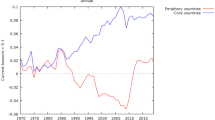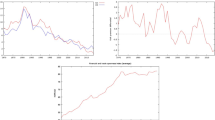Abstract
Financial deregulation in 1980 potentially altered key relationships between residential fixed investment (RFI) and key macroeconomic variables. This study uses a vector error correction model to examine relationships between RFI, money, interest rates, and output in pre-deregulation and post-deregulation sub-periods. Results indicate short-term interest rate shocks account for much of RFI variability pre-deregulation. After deregulation, long-term FHA interest rate shocks better account for RFI movements. Results also show that, in the post-deregulation era, RFI shocks have increased predictive power for overall gross domestic product movements. Thus, the study finds altered relationships between RFI and macroeconomic variables.
Similar content being viewed by others
References
Bernanke, B. (1983). “The Determinants of Investment: Another Look,” American Economic Association, Papers and Proceedings May, 71-74.
Chowdhury, A. R., J. S. Fackler, and W. D. McMillian. (1985). “Monetary Policy, Fiscal Policy and Investment Spending: An Empirical Analysis,” Southern Economic Journal 52, 794-805.
Coulson, N. E., and M.-S. Kim. (2000). “Residential Investment, Non-residential Investment and GDP,” Real Estate Economics 28(2), 233-247.
Coxwell, T. (2000). “An Empirical Investigation of the Relationships Between Money, Interest Rates, Investment and Output: A Disaggregated Approach.” Ph.D. Dissertation, University of Tennessee.
Daniell, R. A. (1991). “The Effects of Monetary Policy, Inflation, and Interest Rates on Residential Fixed Investment: An Empirical Analysis.” Ph.D. Dissertation, University of Tennessee.
Dokko, Y., R. H. Edelstein, and S. E. Urdang. (1990). “Does Credit Rationing Affect Residential Investment? Déjà Vu All Over Again,” Journal of Real Estate, Finance, and Economics 3, 357-371.
Duca, J. V., and S. S. Rosenthal. (1991). “An Empirical Test of Credit Rationing in the Mortgage Market,” Journal of Urban Economics 2, 218-234.
Enders, W. (1995). Applied Econometric Time Series. New York: John Wiley and Sons.
Engle, R. F., and C. W.J. Granger. (1987). “Co-integration and Error Correction: Representation, Estimation, and Testing,” Econometrica 55(2), 251-276.
Garrison, C. B. (1991). “The Role of Business Investment, Residential Investment, and Tax Incentives in the Economic Expansion of the 1980's,” American Economic Journal 19(4), 11-18.
Goodwin, T. H. (1986). “The Impact of Credit Rationing on Housing Investment: A Multi-Market Disequilibrium Approach,” International Economic Review 27, 2.
Green, R. (1997). “Follow the Leader: How Changes in Residential and Non-residential Investment Predict Changes in GDP,” Real Estate Economics 25(2), 253-70.
Greenwald B. C., and J. E. Stiglitz. (1993). “Financial Market Imperfections and Business Cycles,” Quarterly Journal of Economics 108, 77-114.
Hall, R. E. (1977). “Investment, Interest Rates, and the Effects of Stabilization Policies,” Brookings Papers on Economic Activity 1, 61-103.
Hamilton, J. D. (1994). Time Series Analysis. Princeton, NJ: Princeton University Press.
Kahn, G. A. (1989). “The Changing Interest Sensitivity of the U.S. Economy,” Federal Reserve Bank of Kansas City, Economic Review (November), 13-34.
Kent, R. J. (1980). “Credit Rationing and the Home Mortgage Market,” Journal of Money, Credit and Banking 12, 488-501.
Lawrence, C., and A. Siow. (1985). “Interest Rates and Investment Spending: Some Empirical Evidence for Postwar U.S. Producer Equipment, 1947–1980,” Journal of Business 58, 359-375.
McConnell, M. M., P. C. Mosser, and G. P. Quiros. (1999). “A Decomposition of the Increased Stability of GDP Growth,” Current Issues in Economics and Finance, Federal Reserve Bank of New York, 5, 13.
Osterwald-Lenum, M. (1992). “A Note with Quantiles of the Asymptotic Distribution of the Maximum Likelihood Cointegration Rank Test Statistics,” Oxford Bulletin of Economics and Statistics 54, 461-472.
Pozdena, R. J. (1990). “Do Interest Rates Still Affect Housing,” Federal Reserve Bank of San Francisco, Economic Review (Summer), 3-14.
Schwab, R. (1983). “Real and Nominal Interest Rates and the Demand for Housing,” Journal of Urban Economics 13, 181-195.
Shbikat, G. (2001). “The Liquidity Effect of the Transmission Mechanism of Money,” Applied Economics Letters 8(12), 779-785.
Sims, C. (1972). “Money, Income and Causality,” American Economic Review 62, 540-552.
Sims, C. (1980). “Comparison of Interwar and Postwar Business Cycles: Monetarism Reconsidered,” American Economic Review 70(2), 250-257.
Topel, R., and S. Rosen. (1988). “Housing Investment in the United States,” Journal of Political Economy 96(4), 718-739.
Van Order, R., and A. Dougherty. (1991). “Housing Demand and Real Interest Rates,” Journal of Urban Economics 2, 191-201.
Author information
Authors and Affiliations
Rights and permissions
About this article
Cite this article
Gauger, J., Coxwell Snyder, T. Residential Fixed Investment and the Macroeconomy: Has Deregulation Altered Key Relationships?. The Journal of Real Estate Finance and Economics 27, 335–354 (2003). https://doi.org/10.1023/A:1025842108205
Issue Date:
DOI: https://doi.org/10.1023/A:1025842108205




